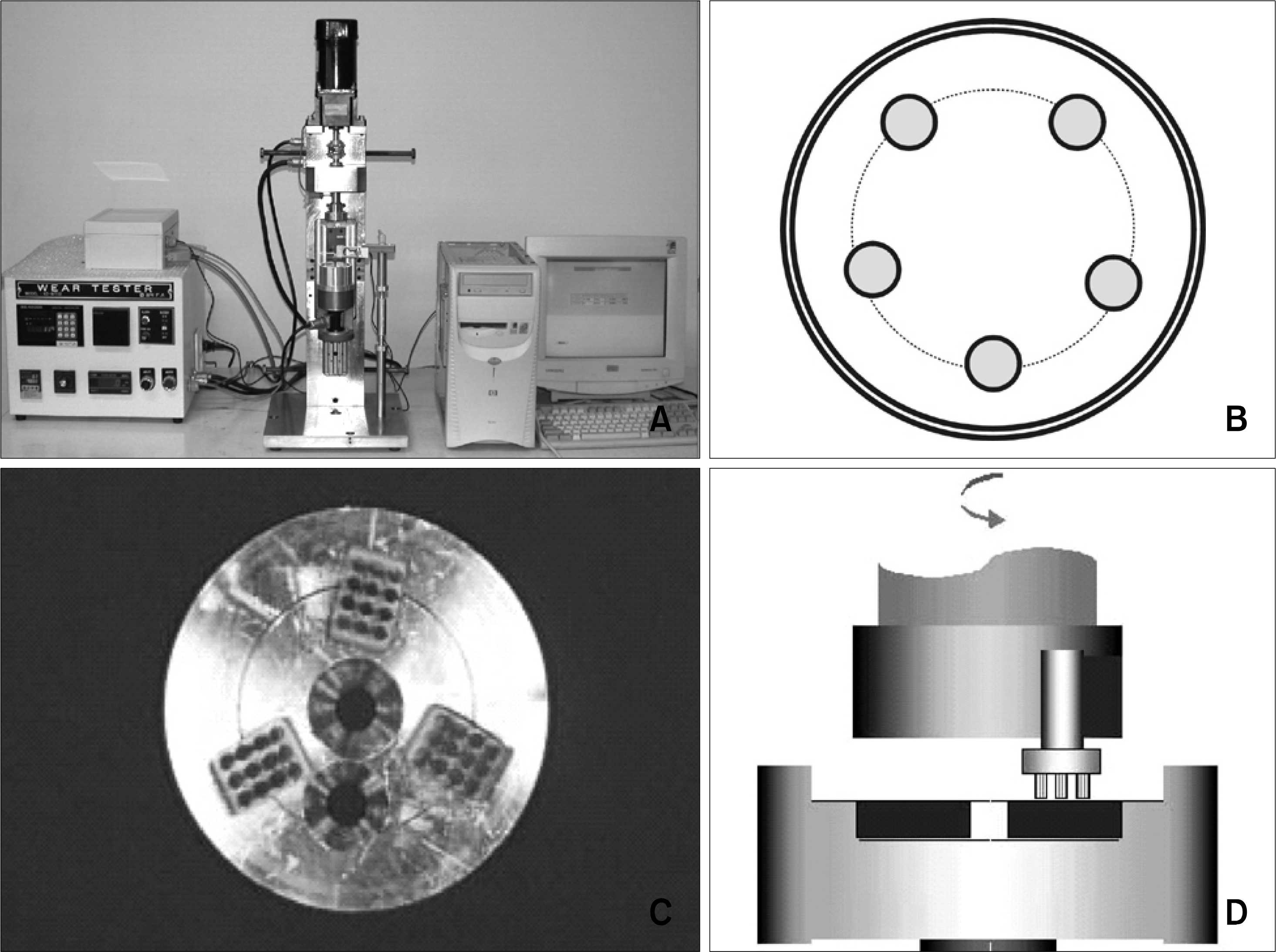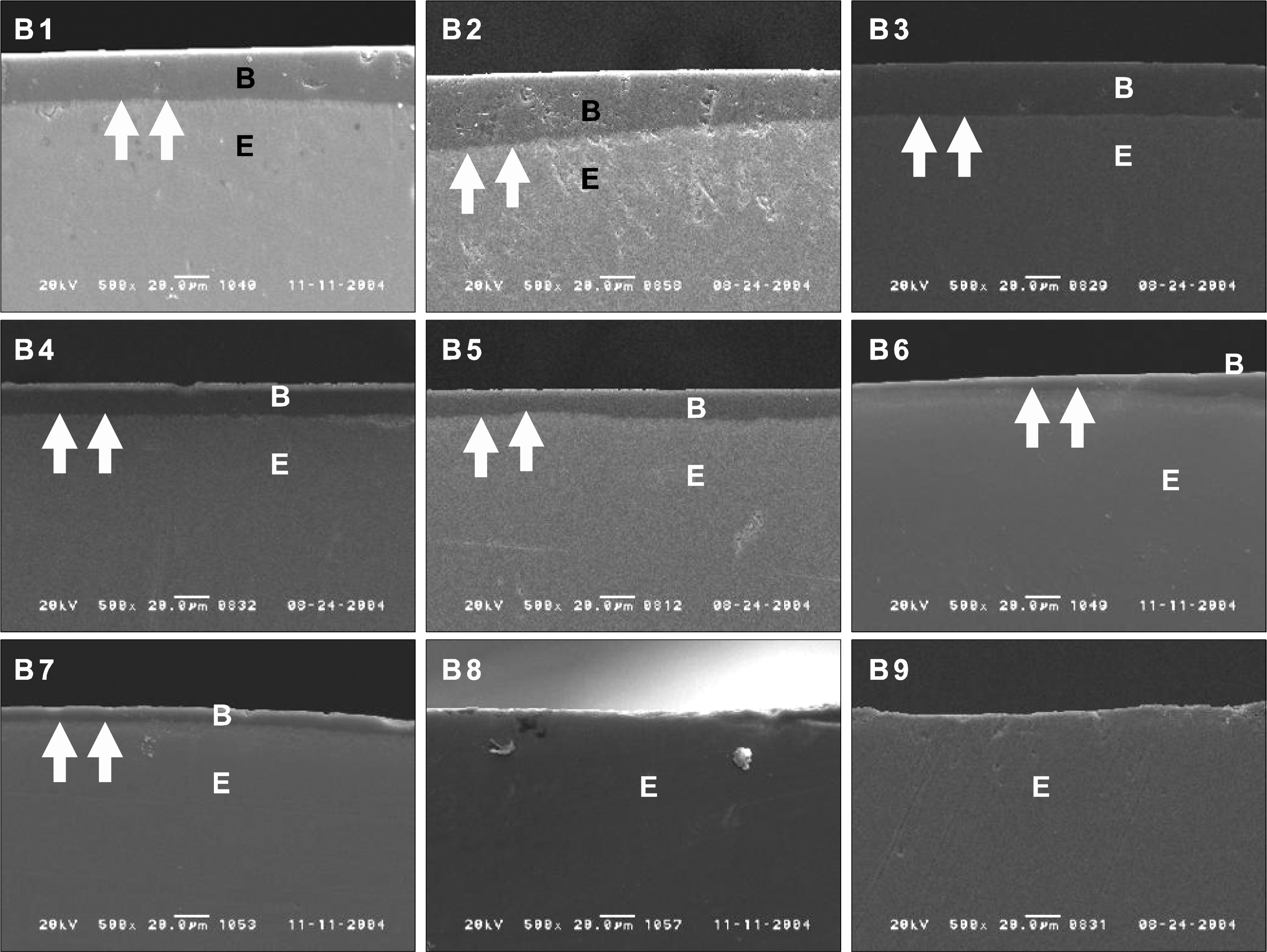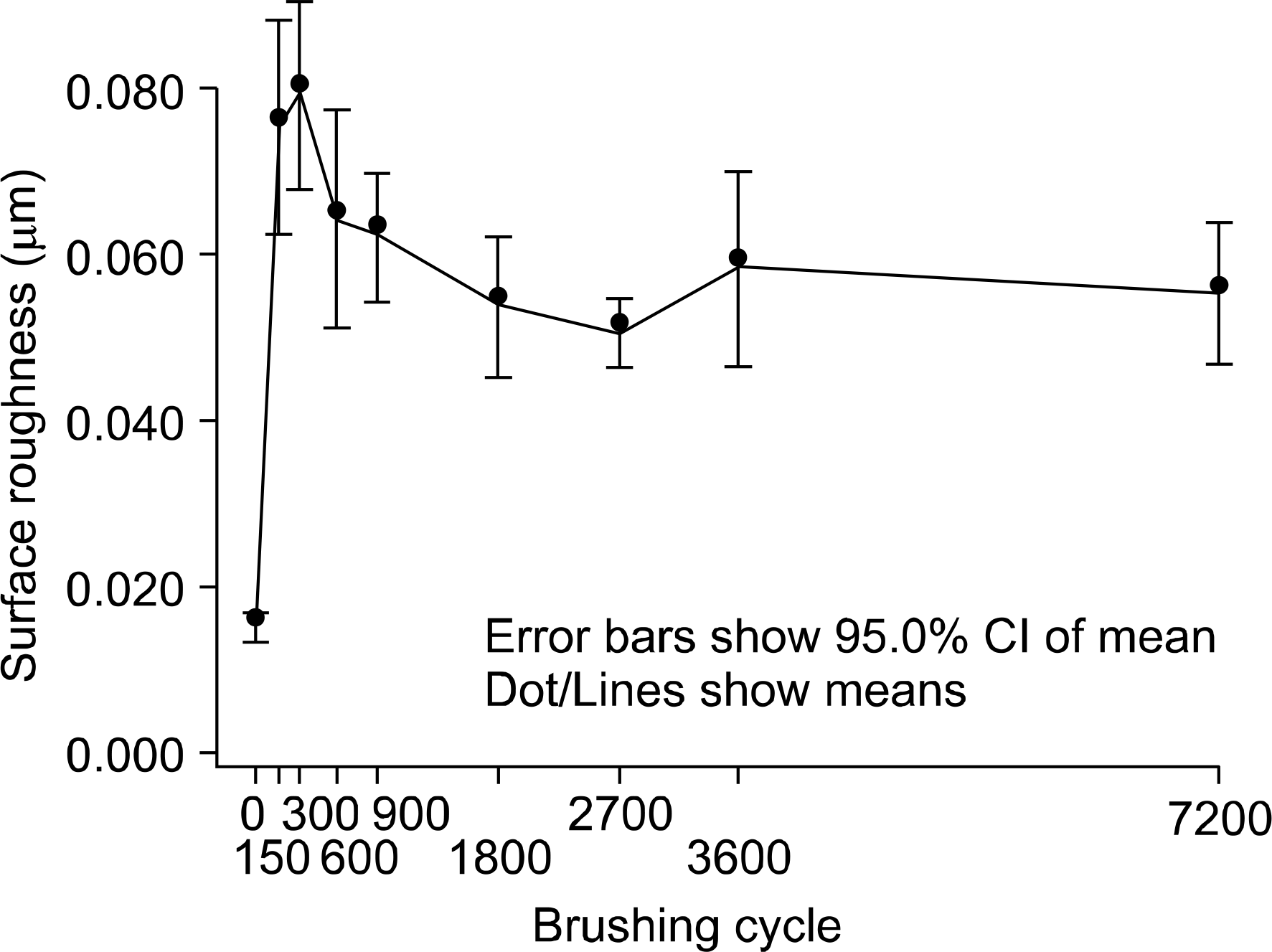Abstract
Objective:
The aim of this study was to investigate the experimental brush wear pattern of a light cured surface sealant, Biscover (Bisco, Schaumburg, IL), and to evaluate its cariostatic effect.
Methods:
Caries-free human premolars were used for the Biscover coating group (n = 90) and the control group (n = 10). The Biscover coating group was randomly assigned to nine subgroups of 10 each and the control group was assigned to two subgroups of 5 each according to the number of brushing strokes. An experimental 3-body wear test was conducted under different strokes of wear test. Tooth-brushing was accomplished with movement of each brush head set at a frequency of 100 rpm under a force of 1.5 N. Surface roughness was tested before, and after Biscover coating, and after brushing. Then, each of the 10 teeth of both groups were placed in artificial caries inducing solution for 7 days. All tooth surfaces were assessed using scanning electron microscopy.
Results:
Biscover coated surfaces showed a smoother texture than enamel surfaces. The roughness was increased after experimental brushing and after 10,800 brushing strokes, the whole layer of Biscover wore out. However, teeth in the Biscover coating group had a cariostatic effect in cariogenic conditions.
Go to : 
REFERENCES
1.Chapra A., White GE. Leakage reduction with a surface-penetrating sealant around stainless-steel orthodontic brackets bonded with a light cured composite resin. J Clin Pediatr Dent. 2003. 27:271–6.

2.Schmit JL., Staley RN., Wefel JS., Kanellis M., Jakobsen JR., Keenan PJ. Effect of fluoride varnish on demineralization adjacent to brackets bonded with RMGI cement. Am J Orthod Dentofacial Orthop. 2002. 122:125–34.

3.Bertrand MF., Leforestier E., Muller M., Lupi-Pégurier L., Bolla M. Effect of surface penetrating sealant on surface texture and microhardness of composite resins. J Biomed Mater Res. 2000. 53:658–63.

4.Ramos RP., Chinelatti MA., Chimello DT., Dibb RG. Assessing microleakage in resin composite restorations rebonded with a surface sealant and three low-viscosity resin systems. Quintessence Int. 2002. 33:450–6.
5.Twetman S., Hallgren A., Petersson LG. Effect of an antibacterial varnish on mutans streptococci in plaque from enamel adjacent to orthodontic appliances. Caries Res. 1995. 29:188–91.

6.Dickinson GL., Leinfelder KF. Assessing the long-term effect of a surface penetrating sealant. J Am Dent Assoc. 1993. 124:68–72.

7.dos Santos PH., Consani S., Correr Sobrinho L., Coelho Sinhoreti MA. Effect of surface penetrating sealant on roughness of posterior composite resins. Am J Dent. 2003. 16:197–201.
8.Kawai K., Leinfelder KF. Effect of surface-penetrating sealant on composite wear. Dent Mater. 1993. 9:108–13.

9.Ferdianakis K. Microleakage reduction from newer esthetic restorative materials in permanent molars. J Clin Pediatr Dent. 1998. 22:221–9.
10.Song JH. Shear, Tensile and Shear/Tensile combined bond strength of metal orthodontic bracket applied with Biscover. 2004. M.S. Thesis in Chonbuk National University.
11.Lee IG. Effect on the color stability of stained porcelain due to tooth brushing. 2002. M.S. Thesis in Chonbuk National University.
12.Takeuchi CY., Orbegoso Flores VH., Palma Dibb RG., Panzeri H., Lara EH, et al. Assessing the surface roughness of a posterior resin composite: effect of surface sealing. Oper Dent. 2003. 28:281–6.
13.McCracken GI., Janssen J., Swan M., Steen N., de Jager M., Heasman PA. Effect of brushing force and time on plaque removal using a powered toothbrush. J Clin Periodontol. 2003. 30:409–13.

14.Van der Weijden GA., Timmerman MF., Versteeg PA., Piscaer M., Van der Velden U. High and low brushing force in relation to efficacy and gingival abrasion. J Clin Periodontol. 2004. 31:620–4.

15.van der Weijden GA., Timmerman MF., Reijerse E., Reijerse E., Snoek CM., van der Velden U. Toothbrushing force in relation to plaque removal. J Clin Periodontol. 1996. 23:724–9.

16.Heasman PA., MacGregor ID., Wilson Z., Kelly PJ. Toothbrushing forces in children with fixed orthodontic appliances. Br J Orthod. 1998. 25:187–90.

17.Neme AM., Wagner WC., Pink FE., Frazier KB. The effect of prophylactic polishing pastes and toothbrushing on the surface roughness of resin composite materials in vitro. Oper Dent. 2003. 28:808–15.
18.Yap AU., Teo JC., Teoh SH. Comparative wear resistance of reinforced glass ionomer restorative materials. Oper Dent. 2001. 26:343–8.
19.Davidson CL., Bekke-Hoekstra IS. The resistance of superficially sealed enamel to wear and carious attack in vitro. J Oral Rehabil. 1980. 7:299–305.

20.Marquis PM., Hu X., Shortall AC. Two-body wear of dental composites under different loads. Int J Prosthodont. 2000. 13:473–9.
21.Vorhies AB., Donly KJ., Staley RN., Wefel JS. Enamel demineralization adjacent to orthodontic brackets bonded with hybrid glass ionomer cements: an in vitro study. Am J Orthod Dentofacial Orthop. 1998. 114:668–74.

22.Todd MA., Staley RN., Kanellis MJ., Donly KJ., Wefel JS. Effect of a fluoride varnish on demineralization adjacent to orthodontic brackets. Am J Orthod Dentofacial Orthop. 1999. 116:159–67.

23.Xie J., Flaitz CM., Hicks MJ., Powers JM. Bond strength of composite to sound and artificial carious dentin. Am J Dent. 1996. 9:31–3.
Go to : 
 | Fig 1.Specimens and Biscover. A, Teeth in resin block and mold (diameter, 50 mm; height, 10 mm); B, Biscover syringe type. |
 | Fig 2.Wear tester. A, wear tester, pin on disk type (Model KD-WT02, Kwangduck FA. Gwangju, Korea); B, five teeth were subjected to wear tester simultaneously; C, tester brush, 3-raw brushes with soft bristles (Gum 311, Jone O Butler, Chicago, IL). Three tester brushes were positioned at 120o intervals; D, an illustration of wear test and tooth paste (Perio A+ Total effect tooth paste; LG Chemical Co, Seoul, Korea). |
 | Fig 4.SEM micrographs of the section faces of Biscover coated teeth. Before brushing & after brushing (× 500). B1, no brushing strokes (0 month); B2, 450 brushing strokes (0.5 month); B3, 900 brushing strokes (1 month); B4, 1,800 brushing strokes (2 months); B5, 2,700 brushing strokes (3 months); B6, 5,400 brushing strokes (6 months); B7, 8,100 brushing strokes (9 months); B8, 10,800 brushing strokes (12 months); B9, 21,600 brushing strokes (24 months). Abbreviations, B, Biscover; E, enamel; arrow, border line between Biscover and enamel. |
 | Fig 5.SEM micrographs of the surface of Biscover coated teeth. Before brushing & after brushing (× 2,000). B1, no brushing strokes (0 month); B2, 450 brushing strokes (0.5 month); B3, 900 brushing strokes (1 month); B4, 1,800 brushing strokes (2 months); B5, 2,700 brushing strokes (3 months); B6, 5,400 brushing strokes (6 months); B7, 8,100 brushing strokes (9 months); B8, 10,800 brushing strokes (12 months); B9, 21,600 brushing strokes (24 months). |
 | Fig 6.SEM micrographs of the surface of Biscover coating group & control group after artificial caries examination (× 500). B8 and C1, 10,800 brushing strokes (12 months); B9 and C2, 21,600 brushing strokes (24 months). |
Table 1.
Composition of Biscover
| Ingredients | Content(weight%) |
|---|---|
| Ethoxylatedbisphenol-a-diacrylate | 20-50 |
| Urethaneacrylester | 20-40 |
| Polyethleneglycoldiacrylate | 20-40 |
Table 2.
Classification of specimen




 PDF
PDF ePub
ePub Citation
Citation Print
Print



 XML Download
XML Download